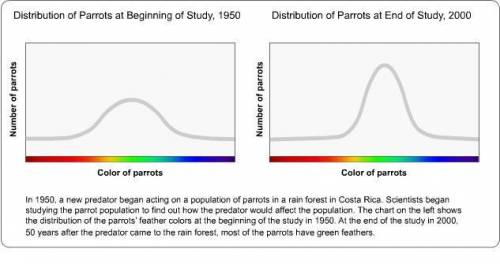
Biology, 07.03.2020 04:22 HELPPPPPfawfds
I HAVE ALREADY CUT OUT THE WRONG ANSWERS ANY ONE WHO CAN ANSWER ALL THE QUESTIONS GETS THE TITTLE OF BRAINLEIST
1. According to the Hardy-Weinberg principle, if p and q are unchanging in a population, the population is in equilibrium. What type of population does this scenario represent?
A. a population that is exposed to many environmental changes
B. a population with constant allele frequencies
C. a population that is experiencing rapid genetic mutations
2. In which scenario below would natural selection be most successful?
A. a population of salmon with different skin colors that attract mates
B. a population of parakeets that have the same size beak
C. an island with lizards that all look alike and are all eating the same food
4. How does radiometric dating help scientists pinpoint the age of a fossil?
A. In radiometric dating, scientists mix the carbon in a fossil with carbon from similar fossils whose age they know. By comparing the carbon, they can tell the exact age of the fossil.
B. Radiometric dating shows the rate of decay of radioactive material present in any object. Scientists can use that data to find the absolute age of the fossil.
C. Radiometric dating allows scientists to find fossils in only the lowest and oldest layers of sediment.
5. Fossil evidence suggests that whales evolved from land mammals. Using comparative DNA techniques, scientists have also suggested that whales are related to hippos. How could comparing amino acid sequences support the theory of evolution?
A. Comparing amino acid sequences showed that stabilizing selection took place in a population of hippos, resulting in the formation of a new species of whale.
C. By comparing amino acid sequences, scientists were able to prove that whales evolved from hippopotamus ancestors.
D. Comparing amino acid sequences can show close genetic relationships between organisms that may appear very different, such as whales and hippos.
6.Which sentence best describes vestigial structures?
A. All animals have them.
B. They may have had an important function in the past.
D. They contain genetic mutations.
7.A bird's wing, a dolphin's flipper, and a cat's paw are homologous structures. What about these structures supports the theory of evolution?
A. They are good examples of vestigial structures.
B. They prove that the limbs of all land animals evolved from wings and fins.
C. They are evidence that the animals had a common ancestor.
8.How does comparing the embryos of different organisms support the theory of evolution?
A. The embryos of all organisms are identical.
C. The stages of development of the embryos of different organisms are extremely similar, thereby suggesting common ancestors.
9. Why was Charles Darwin able to offer a large amount of evidence for his theory of evolution by natural selection?
A. He compiled the fossil record.
B. He collected data for 5 years while traveling around the world.
C. He conducted in-depth experiments with chemicals in England.
10. Based partially on his comparative studies of the fossils of woolly mammoths and the bones of modern-day elephants, Georges Cuvier proposed several new ideas about the history of life on earth. Which general statement can be made about this example?
A. Through specific studies, new ideas can be developed.
C. All scientific ideas are made by comparing past and present organisms.
D. Understanding the past is not important to studying the present.
11. A population of snails is experiencing disruptive selection in terms of their shell patterns. Which statement is most likely true about the population?
A. Two different shell patterns are increasing in frequency, while the most common pattern is decreasing.
B. Two different patterns are combining into one very common pattern.
C. The frequency of a new shell pattern is becoming higher than all other patterns.
12. Which type of selection is illustrated by these two graphs?
A. stabilizing
B. directional
D. natural


Answers: 3
Another question on Biology

Biology, 21.06.2019 22:00
Which is the correct first step in finding the area of the base of a cylinder with a volume of 26x cubic meters and a height of 6.5 meters? v=bh 6.5=b(26x) v=bh v=26pi+(6.5) v=bh v=26pi(6.5) v=bh 26pi=b(6.5)
Answers: 1

Biology, 22.06.2019 01:30
What is turgor pressure, what causes it, and what does it do for a plant?
Answers: 3

Biology, 22.06.2019 03:00
1. watermelon, papaya, oranges, bananas, and lemons are included in this food group. vitamin c 2. you need 6 or more servings of this food group each day vitamins d and a 3. found in fruit and keeps blood vessels healthy calcium 4. vitamins found in milk bread and grain 5. a mineral that strengthens bones fruit
Answers: 3

Biology, 22.06.2019 04:00
Aflame cell is at the end of each tubule of the nephridium malpighian tubules kidneys none of the above
Answers: 1
You know the right answer?
I HAVE ALREADY CUT OUT THE WRONG ANSWERS ANY ONE WHO CAN ANSWER ALL THE QUESTIONS GETS THE TITTLE OF...
Questions

Computers and Technology, 20.09.2020 03:01

Arts, 20.09.2020 03:01

Biology, 20.09.2020 03:01

Social Studies, 20.09.2020 03:01


Mathematics, 20.09.2020 03:01

Mathematics, 20.09.2020 03:01





Computers and Technology, 20.09.2020 03:01

Chemistry, 20.09.2020 03:01

English, 20.09.2020 03:01





Mathematics, 20.09.2020 03:01

Mathematics, 20.09.2020 03:01



